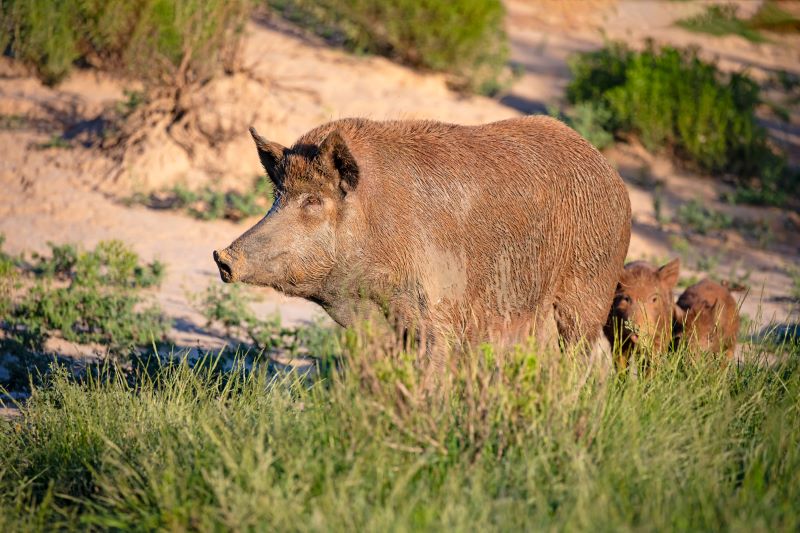
Hunting Invasive Species for the Environment
Hunting has driven many species to extinction, while many more species continue to be threatened by poachers. But when hunters turn their attention to invasive species, they can provide an environmental benefit. In some places, authorities encourage hunting invasive species by making it a competitive sport. Here are a few ways that hunters can use their skills to benefit the environment – and sometimes even win prizes.
Feral Hogs in Texas
Collared peccaries, also known as javelinas, are a type of wild boar that is native to the desert Southwest. But even though there is a pig-like niche in this desert environment, it’s a real problem when pigs colonize the desert. Some 2.6 million feral hogs in Texas cause an estimated $500 million in damage every year.
The Texas A&M AgriLife Extension Service – Wildlife Services funds a grant program through which the Central Texas Feral Hog Task Force offers hunters bounties in affected counties in Texas. In 2020, these bounties, combined with other measures, were used to remove 2,877 feral swine from the tri-county region. The program has mitigated approximately $1,438,500 in ecological and property damage.

Burmese Pythons in Florida
Florida is home to many snake species. But as their name would suggest, Burmese pythons are not naturally among them. However, once introduced to the Everglades and south Florida, the pythons thrived. A female Burmese python can lay 50 to 100 eggs at a time. This expanding population negatively impacts the ecosystem by preying on native species of birds, reptiles, and mammals.

Anyone can kill Burmese pythons humanely on private lands in Florida – with the landowner’s permission. But for 10 days each year, the Florida Python Challenge turns python hunting into a competition. In 2022, nearly 1,000 people traveled from 32 states and three countries to compete for prizes. including $2,500 for Most Pythons Caught and $750 for Longest Python.
Lionfish in Florida
Venomous and predatory, lionfish are native to the Indian Ocean. But once introduced to Atlantic waters, they have spread up the Atlantic Coast, around to the Bahamas, and then into the Gulf of Mexico. They eat native species that serve important ecological roles in coral reefs.
The Florida Fish and Wildlife Conservation Commission encourages divers to remove lionfish to minimize their impact. Accordingly, Reef Environmental Education Foundation hosts Lionfish Derbies – single day competitions to collect and remove as many lionfish as possible. These events help control lionfish populations in more ways than one; they train divers to safely collect and handle venomous lionfish, provide specimens for scientific study, and encourage consumption of lionfish as a culinary dish in local restaurants.

Benefits of Bounties
Although the competitive nature of bounty programs like these is relatively new, bounty programs for the control or elimination of unwanted species are not new. And they haven’t always been used for ecological benefit – native wolves were nearly eradicated through government programs in the last century. Predator bounties for other species – most commonly coyotes – are still common in the American West. However, these are contentious, as they often target species that are naturally part of the ecosystem, and the data is mixed at best as to whether they actually protect threatened prey species.
Despite the fate of species like the dodo, passenger pigeon, and Javan tiger, totally eradicating a species through hunting is not easy, and bounty programs have a history of mixed results. Lionfish bounties in Belize and Mississippi both ran out of funds in a short period of time without making a dent in the population.
Bounty programs are unlikely to eliminate an invasive species. However, under the right circumstances, “functional eradication” is a realistic goal. Functional eradication aims to reduce populations below the level where they damage the ecosystem in priority locations.
Better Bounties
Two factors have been identified that make bounty programs and competitions more effective. First, they should target dense populations in small areas. When a species has naturalized over a large area, competitions are unlikely to harvest a significant percentage of the population. They can even backfire, leading to a population boom as remaining individuals breed more successfully with decreased competition for resources. Hunting competitions should also promote a sustained interest in harvesting the species – as the lionfish derby does by encouraging a culinary interest in the fish.
However, it’s important to consider and plan for ways that native species populations may be impacted directly through by-catch or increased human disturbance. With good data and careful planning, competitive hunting can be part of the successful control of invasive species.
Services Marketplace – Listings, Bookings & Reviews